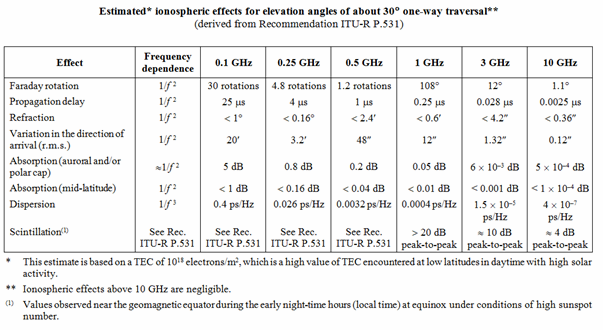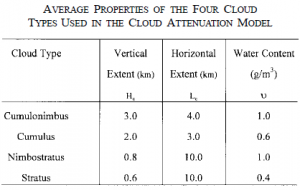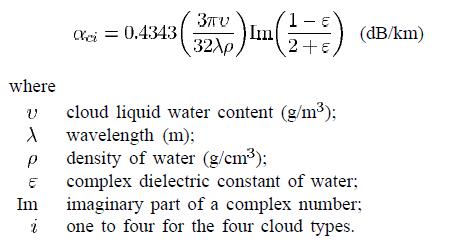Atmospheric Parameters
In an effort to statistically characterize and model V-band propagation phenomena across a wide range of atmospheric and meteorological conditions, it is necessary to recognize distinct atmospheric parameters which affect radio propagation in the V-band frequencies so as to decouple them and correlate with observed signal attenuation, phase distortion, and depolarization measurements.
Propagation phenomena that affect the satellite link occur mainly in the troposphere and the ionosphere. According to ITU-R P.618-10 (see table 1), ionospheric effects are significant for systems operating below 3 GHz while tropospheric effects affect links operating at 3 GHz and over[1].
Table 1. Ionospheric effects
Since ionospheric effects above 10 GHz are negligible, we proceed to examine these effects of the non-ionized atmosphere.
- Free space loss
- A significant loss of signal power can be attributed to free space loss by virtue of the vast distance between Earth stations and satellite. The equation for free-space path loss follows:
- Gaseous absorption
- Water vapour and oxygen exhibit large absorption lines at high frequencies as seen in the model[3] as illustrated in Figure 1.

Figure 1. Gaseous absorption attenuation with frequency
- Rain attenuation
- Cloud attenuation
- As examined in our literature review, cloud attenuation is another significant source of attenuation and the effect varies across different cloud structures[2] due to differences in extent and water content as seen in table 2.
Table 2. Properties of different cloud types
- Specific attenuation of each cloud type is given as follows[2]
- Focusing and defocusing
- Regular decrease of refractive index with height leads to ray-bending and results in a defocusing effect at low angles of elevation. Defocusing loss of the antenna beam is independent of frequency, from 1 – 100 GHz.
- Decrease in antenna gain due to wave-front incoherence
- This effect is the result of small scale irregularities in the refractive index structure of the atmosphere. It increase with increasing frequency and decreasing elevation angle.
- Scintillation
- Tropospheric scintillation is caused by small-scale fluctuations of the refractive index due to turbulence. It increases with frequency and path length through medium, and decreases with decreasing beamwidth. It could represent a significant source of additional power loss over long distances.
- Multipath effects
- Multipath effects result in signal fading and are caused by large obstacles such as buildings and hills. This is a significant effect at low elevation angles and is highly dependent on environment conditions.
- Noise temperature
- For Earth stations with low-noise front-ends, this increase of noise temperature may have a greater impact on the resulting signal-to-noise ratio than the attenuation itself. Radiation from the sky and space also contributes to overall noise temperature as well.
- Depolarization
- Radio waves experience depolarization by atmospheric hydrometeors in earth-space paths. Depolarization leads to interference and reduces the link capacity for orthogonally polarized radio signals in Earth-space transmission. Both linearly polarized and circularly polarized waves are susceptible to depolarization.
As a rule according to ITU-R P.618-10, at elevation angles above 10°, only gaseous attenuation, rain and cloud attenuation and possibly scintillation will be significant[1]. Since our choice of Earth stations have elevation angles above 40°, these are the major conditions of concern in our channel characterization and modeling.
See: Atmospheric Attenuation Data
References:
[1] P.618 : Propagation data and prediction methods required for the design of Earth-space telecommunication systems. http://www.itu.int/rec/R-REC-P.618-10-200910-I/en.
[2] Dissanayake, A. , Clarksburg, MD, Allnutt, J. , Haidara, F., ”A prediction model that combines rain attenuation and other propagation impairments along Earth-satellite paths”, IEEE Transactions on Antennas and Propagation, Oct 1997.
[3] P.676 : Attenuation by atmospheric gases. http://www.itu.int/rec/R-REC-P.676/en.
[4] Stutzman, W. L., and W. K. Dishman (1982), A simple model for the estimation of rain-induced attenuation along earth-space paths at millimeter wavelengths, Radio Sci., 17(6), 1465–1476.
[5] P.837 : Characteristics of precipitation for propagation modelling. http://www.itu.int/rec/R-REC-P.837-6-201202-I/en.






